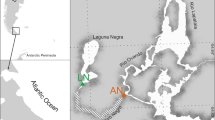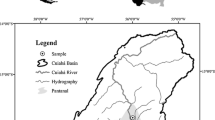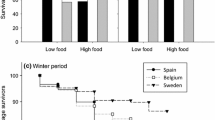Summary
We argue, based on reviewed literature covering reptiles, amphibians, birds, and fish, that fat storage may represent a life history adaptation because it enables an organism to shift in time when resources are allocated to reproduction. We applied these arguments to fat and population cycles in three populations of the mosquito fish, Gambusia affinis. For males, there appeared to be a constant size at maturation during the reproductive season. Mature males became scarce late in the summer. At the same time, immature males delayed maturity and attained much larger sizes; they matured in large numbers in the fall. The amount of stored fat tended to be equal for immature and mature males at all times except in the late summer. In the August samples, when mature males were relatively rare, they also had the lowest level of fat reserves. It appears that the older generation of mature males did not store fat and did not overwinter. At the same time, immature males registered a two to three fold increase in fat reserves. These differences in fat content between mature and immature males disappeared by September, probably because of the recruitment of a new generation of mature males. The reserves were gradually utilized during the winter. Females reproduced from the late spring through mid- to late-summer. They stopped reproducing in the late summer, when there was ample time to produce an additional litter of young. There was an inverse relationship between resources devoted to reproduction and fat reserves. As reproductive allotment decreased in the late summer, fat reserves increased. The magnitude of the change in fat reserves was similar to that displayed by males. The reserves were depleted over the winter. Significant reserves remained at the beginning of the reproductive season the following spring. Reproducing females utilized the remaining reserves significantly more rapidly than non-reproducing females. An analysis of resource availability revealed an overall decrease in food availability in the late summer, coincident with the increase in fat reserves. These cycles are therefore not attributable to changes in resource availability. They instead indicate a change in how resources are allocated by the fish. The trends in the data indicate that fat reserves are used to shift investment in reproduction from the late summer to the following spring. In males, deferring maturity, rather than maturing in August, allows them to store the necessary reserves to survive the winter so that they can mate the following spring. In females, a subset of the fat reserves is intended for producing the first clutch of eggs the following spring. The female pattern corresponds to those reported for a diversity of organisms. The possible advantages of shifting reproductive effort from the fall to the following spring include higher fecundity and higher offspring fitness. The limitations of the methodology and potential directions for future research are discussed.
Similar content being viewed by others
References
Alisauskas RT, Aukney CD (1985) Nutrient reserves and the energetics of reproduction in American Coots. The Auk 102:133–144
Ballinger R (1977) Reproductive strategies: food availability as a source of proximal variation in a lizard. Ecology 58:628–635
Ballinger RE, Congdon JD (1981) Population ecology and life history strategy of a Montane lizard (Sceloporus scalaris) in southeastern Arizona. J Nat Hist 15:213–222
Barney RL, Anson BJ (1921a) The seasonal abundance of Gambusia affinis in relation to male frequency. Ecology 2:53–69
Barney RL, Anson BJ (1921b) The seasonal abundance of the mosquito-destroying top-minnow, Gambusia affinis, especially in relation to fecundity. Anat Rec 22:317–334
Borowsky RL (1973) Social control of adult size in males of Xiphophorus variatus. Nature 245:332–335
Brown CJD, Fox AC (1966) Mosquito fish in a Montana pond. Copeia 1966:614–616
Derickson WK (1974) Lipid deposition and utilization in the sagebrush lizard, Sceloporus graciosus: its significance for reproduction and maintenance. Comp Biochem Physiol 49A:267–272
Derickson WK (1976a) Ecological and physiological aspects of reproductive strategies in two lizards. Ecology 57:445–458
Derickson WK (1976b) Lipid storage and utilization in reptiles. Amer Zool 16:711–723
Dobush GR, Aukney CD, Krementz DG (1985) The effect of apparatus, extraction time, and solvent type on lipid extractions of snow geese. Can J Zool 63:1917–1920
Eliassen JE, Vahl O (1982) Seasonal variations in the gonad size and the protein and water content of cod, Gadus morhua (L.), muscle from Northern Norway, J Fish Biol 20:527–533
Fisher RA (1930) The genetical theory of natural selection. Oxford University Press, Oxford
Fitzpatrick LC (1972) Energy allocation in the Allegheny Mountain Salamander Desmognathus ochrophaeus. Ecol Monogr 43:43–58
Fitzpatrick LC (1976) Life history patterns of storage and utilization of lipids for energy in amphibians. Amer Zool 16:725–732
Gaffney FC, Fitzpatrick LC (1973) Energetics and lipid cycles in the lizard C. tigris. Copeia 1973:446–452
Geiser SW (1924) Sex-ratios and spermatogenesis in the top minnow Gambusia holbrooki. Biol Bull 47:175–207
Goldberg SR (1974) Reproduction in mountain and lowland populations of the lizard Sceloporus occidentalis. Copeia 1974:176–182
Goulden CE, Hornig LL (1980) Population oscillations and energy reserves in planktonic cladocera and their consequences to competition. Proc Natl Acad Sci USA 77:1716–1720
Hahn WE, Tinkle DW (1965) Fat body cycling and experimental evidence for its adaptive significance to ovarian follicle development in the lizard Uta stansburiana. J Exp Zool 158:79–86
Harrington RW, Harrington ES (1961) Food selection among fishes invading a high subtropical salt marsh: from onset of flooding through the progress of a mosquito brood. Ecology 42:646–665
Hess AD, Tarzwell CM (1942) The feeding habits of Gambusia affinis, with special reference to the malaria mosquito, Anopholes quadrimaculatus. Am J Hygiene 35:142–151
Hildebrand SF (1917) Notes on the life history of the minnows Gambusia affinis and Cyprinodon variegatus. Ann Rept U S Comm Fish App 6, Doc No 857:3–15
Hildebrand SF (1927) Sex ratio in Gambusia. Biol Bul 53:390–404
Hubbs C (1971) Competition and isolating mechanisms in the Gambusia affinis x Gambusia heterochir hybrid swarm. Bull Tex Mem Mus 19:1–46
Hughes AL (1984) Seasonal trends in male life history straegies in the mosquitofish Gambusia affinis and their adaptive significance. PhD Thesis, Indiana University, Bloomington, Indiana, USA
Hughes AL (1985a) Seasonal changes in fecundity and size at first reproduction in an Indiana population of the mosquitofish Gambusia affinis. Amer Midl Nat 114:30–36
Hughes AL (1985b) Male size, mating success, and mating strategy in the mosquitofish Gambusia affinis (Poeciliidae). Behav Ecol Sociobiol 17:271–278
Hurlbert SH, Mulla MS (1981) Impacts of mosquitofish (Gambusia affinis) predation on plankton communities. Hydrobiol 83:125–151
Jameson EW Jr (1974) Fat and breeding cycles in a montane population of Sceloporus graciosus. J herpetology 8:311–322
Krapu GL (1981) The role of nutrient reserves in mallard reproduction. The Auk 98:29–38
Krapu GL, Iverson GC, Keinecke KJ, Boise CM (1985) Fat deposition and usage by arctic-nesting sandhill cranes during spring. The Auk 102:362–368
Krumholz LA (1948) Reproduction in the western mosquitofish, Gambusia affinis, and its use in mosquito control. Ecol Monogr 18:1–43
Love RM (1970) The chemical biology of fishes. Academic Press, London and New York
Maglio FJ, Rosen DE (1969) Changing preferences for substrate color by reproductively active mosquitofish, Gambusia affinis (Baird and Girard) (Poeciliidae, Atheriniformes). Amer Mus Novitates No 2397
McKinney RB, Marion KR (1985) Reproductive and fat body cycles in the male lizard, Sceloporus undulatus. from Alabama, with comparisons of geographic variation. J herpetology 19:208–217
McLandress MR, Raveling DG (1981) Changes in diet and body composition of Canada geese before spring migration. The Auk 98:65–79
Milton DA, Arthington AH (1983) Reproductive biology of Gambusia affinis holbrooki Baird and Girard, Xiphophorus helleri (Gnther) and Xiphophorus maculatus (Heckel) (Pisces: Poeciliidae) in Queensland, Australia. J Fish Biol 23:23–41
Morton ML (1981) Seasonal changes in total body lipid and liver weight in the Yosemite toad. Copeia 1981:234–238
Nie NH, Hall CH, Jenkins JG, Steinbrenner K, Bent DH (1983) SPSSx User's Guide. McGraw Hill Book Co., New York
Nikolskii GV (1969) Theory of fish population dynamics as the biological background for rational exploration and management of fishery resources. Oliver and Boyd, Edinburg
Nussbaum RA (1981) Seasonal shifts in clutch size and egg size in the side-blotched lizard, Uta stansburiana Baird and Girard. Oecologia (Berlin) 49:8–13
Reznick DN (1981) “Grandfather effects”: the genetics of interpopulation differences in offspring size in the mosquitofish Gambusia affinis. Evolution 35:941–953
Reznick DN (1982) The impact of predation on life history evolution in Trinidadian guppies: the genetic components of observed life history differences. Evolution 36:1236–1250
Reznick DN (1983) The structure of guppy life histories: the tradeoff between growth and reproduction. Ecology 64:862–873
Reznick DN, Endler JA (1982) The impact of predation on life history evolution in Trinidadian guppies (Poecilia reticulata). Evolution 36:160–177
Rose B (1982) Food intake and reproduction in Anolis acutus. Copeia 1982:322–330
SAS Institute Inc (1985) SAS User's Guide: Statistics, Version 5 Edition, Cary, N.C.
Sohn JJ (1977a) Socially induced inhibition of genetically determined maturation in the platyfish, Xiphophorus maculatus. Science 195:199–201
Sohn JJ (1977b) The consequences of predation and competition upon the demography of Gambusia manni (Pisces: Poeciliidae). Copeia 1977:224–227
Sokal RR, Rohlf FJ (1969) Biometry. W.H. Freeman and Company, San Francisco
Stamps JA, Crews DC (1976) Seasonal changes in reproduction and social behavior in the lizard Anolis aeneus. Copeia 1976:467–476
Stearns SC (1975) A comparison of the evolution and expression of life history traits in stable and fluctuating environments: Gambusia affinis in Hawaii. PhD thesis, Univ of British Columbia
Telford SR (1970) Seasonal fluctuations in liver and fat body weights of the Japanese lacertid Takydromus tachydromoides. Copeia 1970:681–689
Tinkle DW (1961) Population structure and reproduction in the lizard Uta stansburiana stejnegeri. Amer Midl Nat 66:206–234
Tinkle DW (1967) The life and demography of the side-blotched lizard, Uta stansburiana. Misc Publ Mus Zool, Univ Mich 132:1–182
Tinkle DW, McGregor D, Dana S (1962) Home range ecology of Uta stansburiana stejnegeri. Ecology 43:223–229
Turner CL (1941) Morphogenesis of the gonopodium in Gambusia affinis affinis. J Morph 69:161–185
Author information
Authors and Affiliations
Rights and permissions
About this article
Cite this article
Reznick, D.N., Braun, B. Fat cycling in the mosquitofish (Gambusia affinis): fat storage as a reproductive adaptation. Oecologia 73, 401–413 (1987). https://doi.org/10.1007/BF00385257
Received:
Issue Date:
DOI: https://doi.org/10.1007/BF00385257




